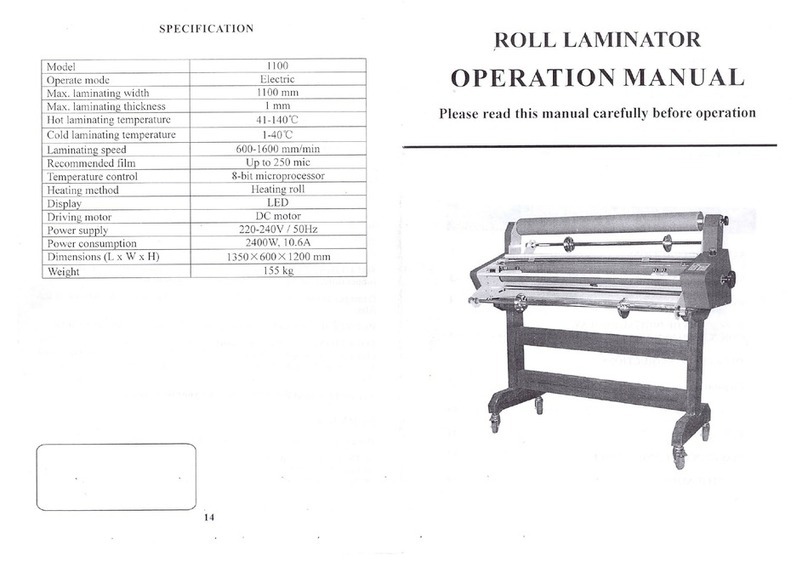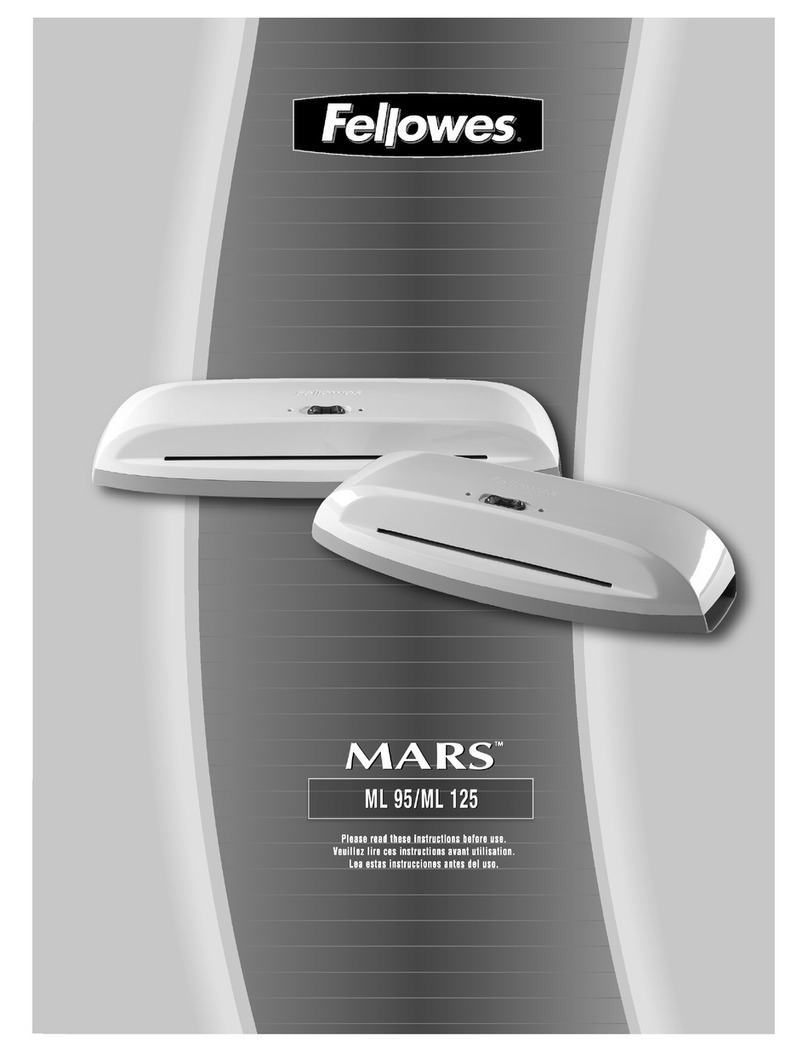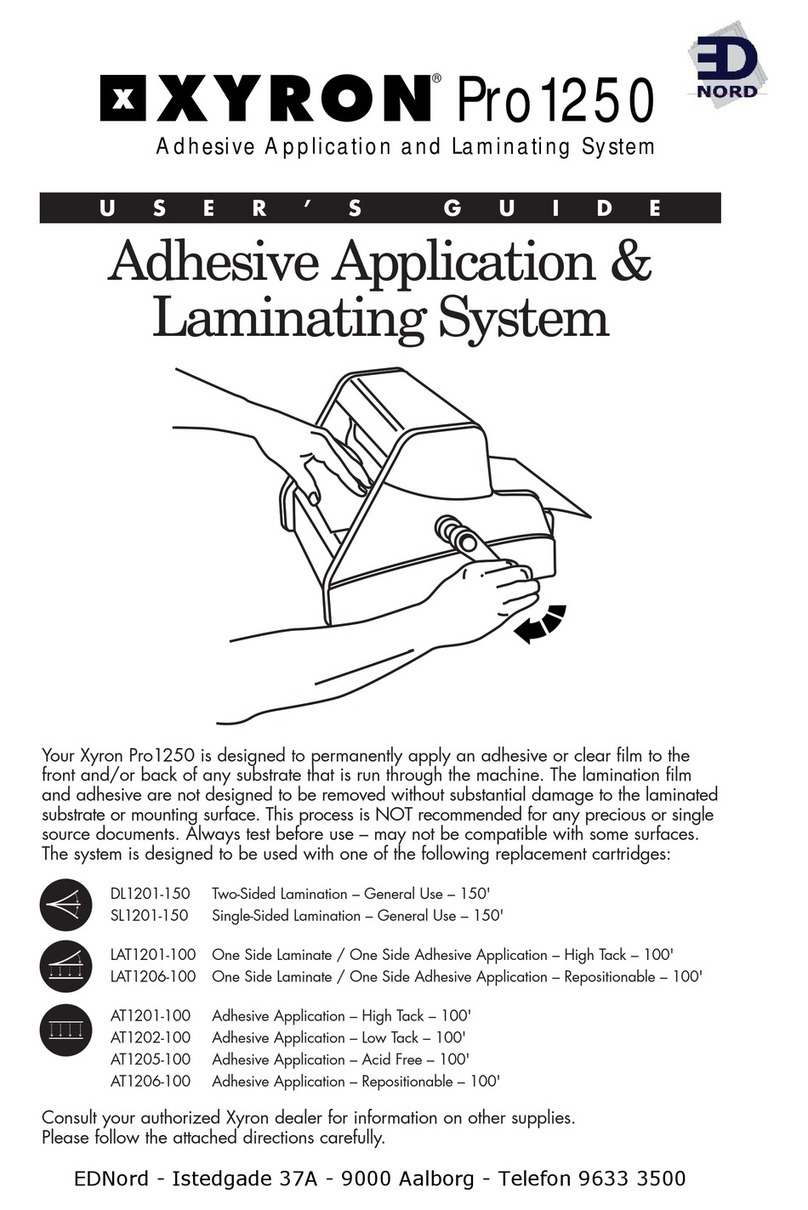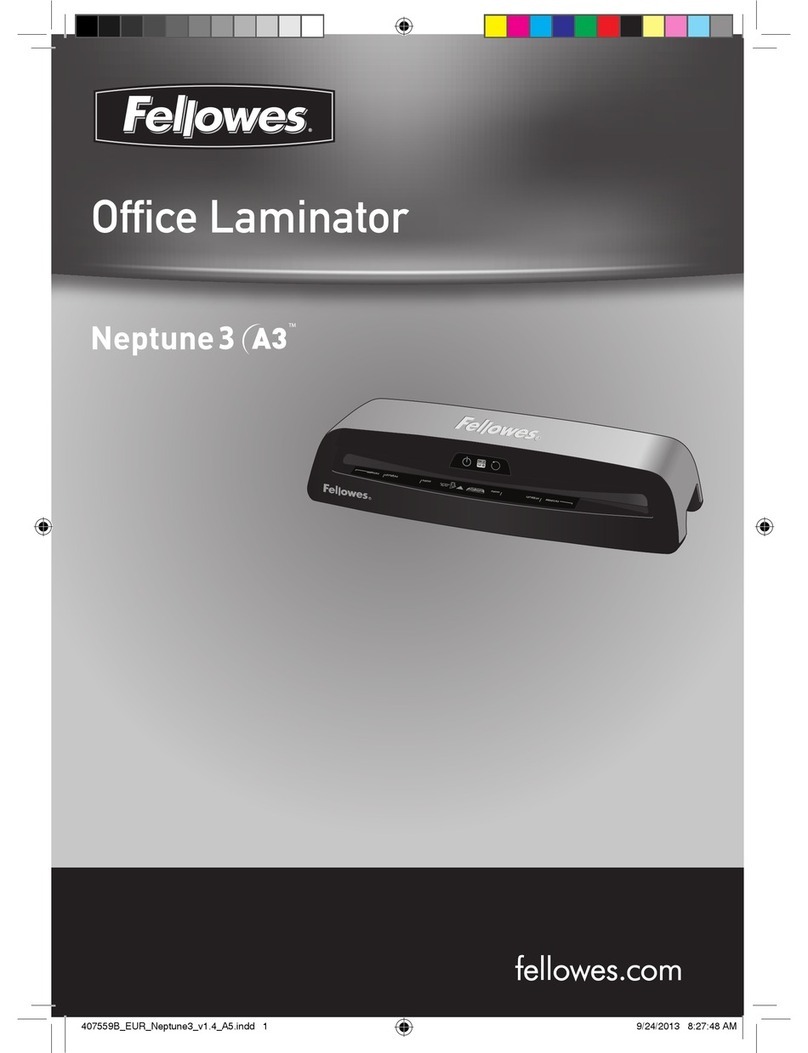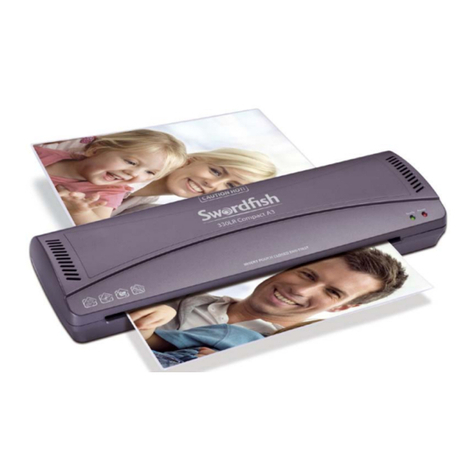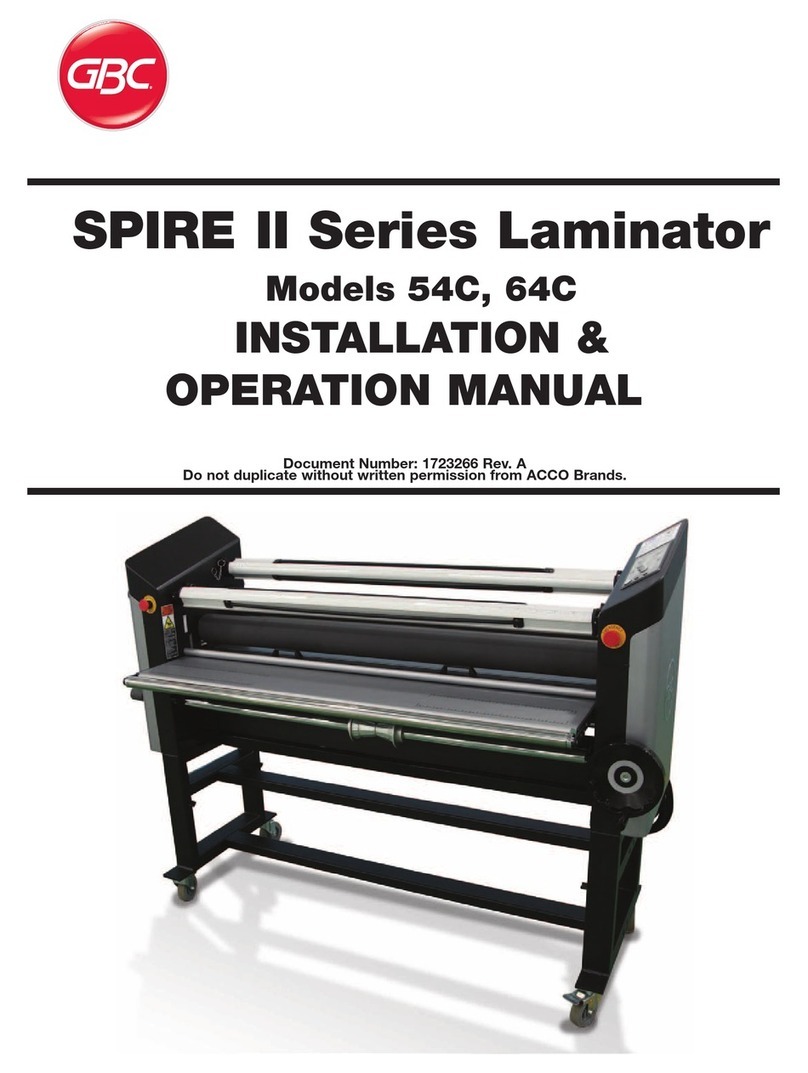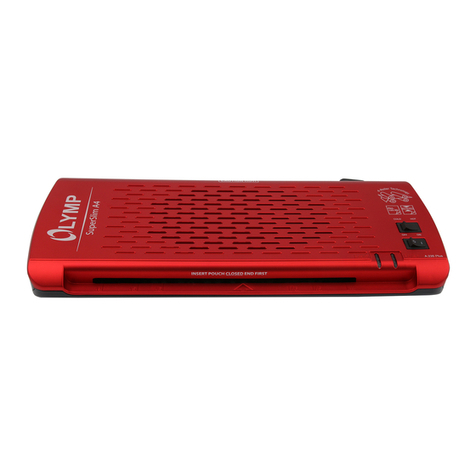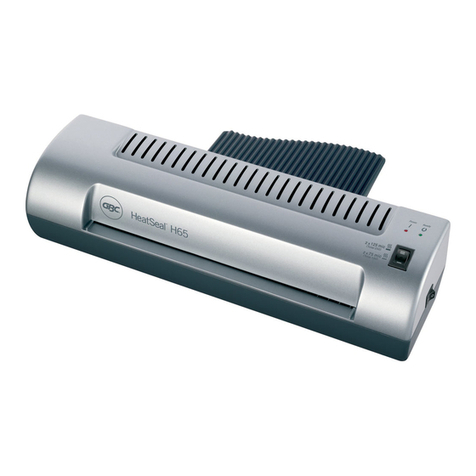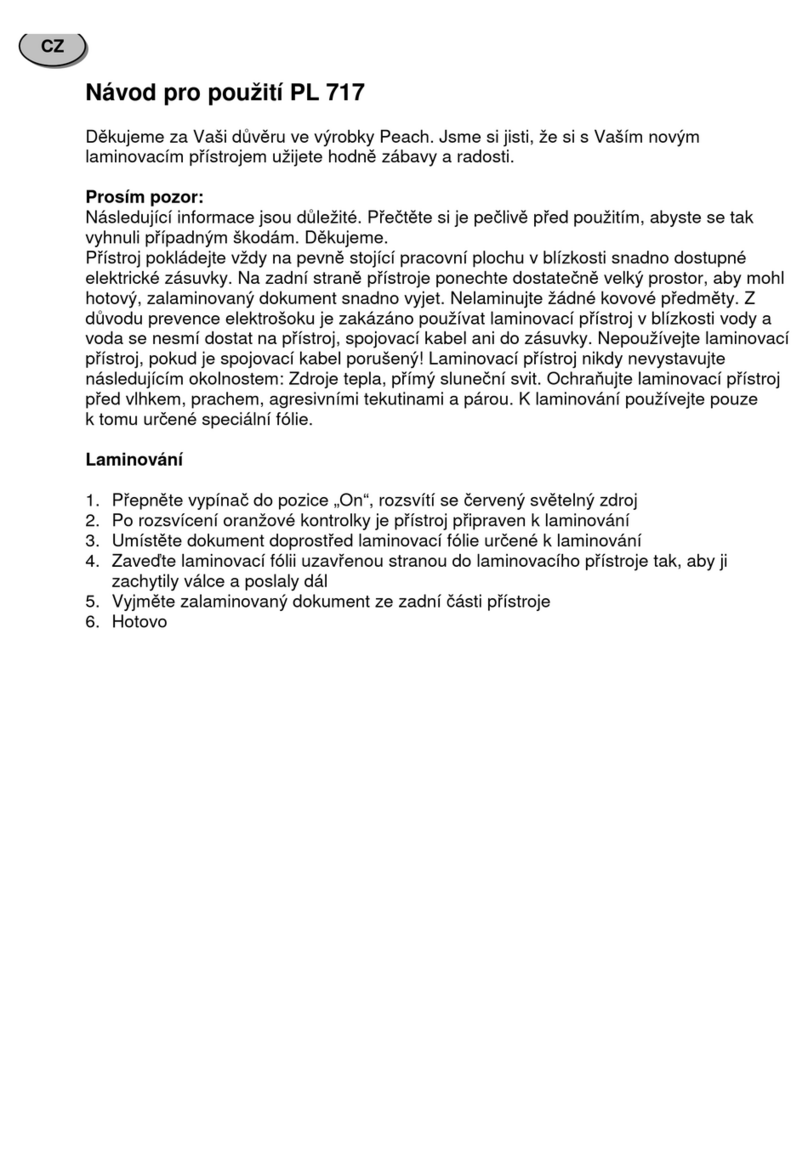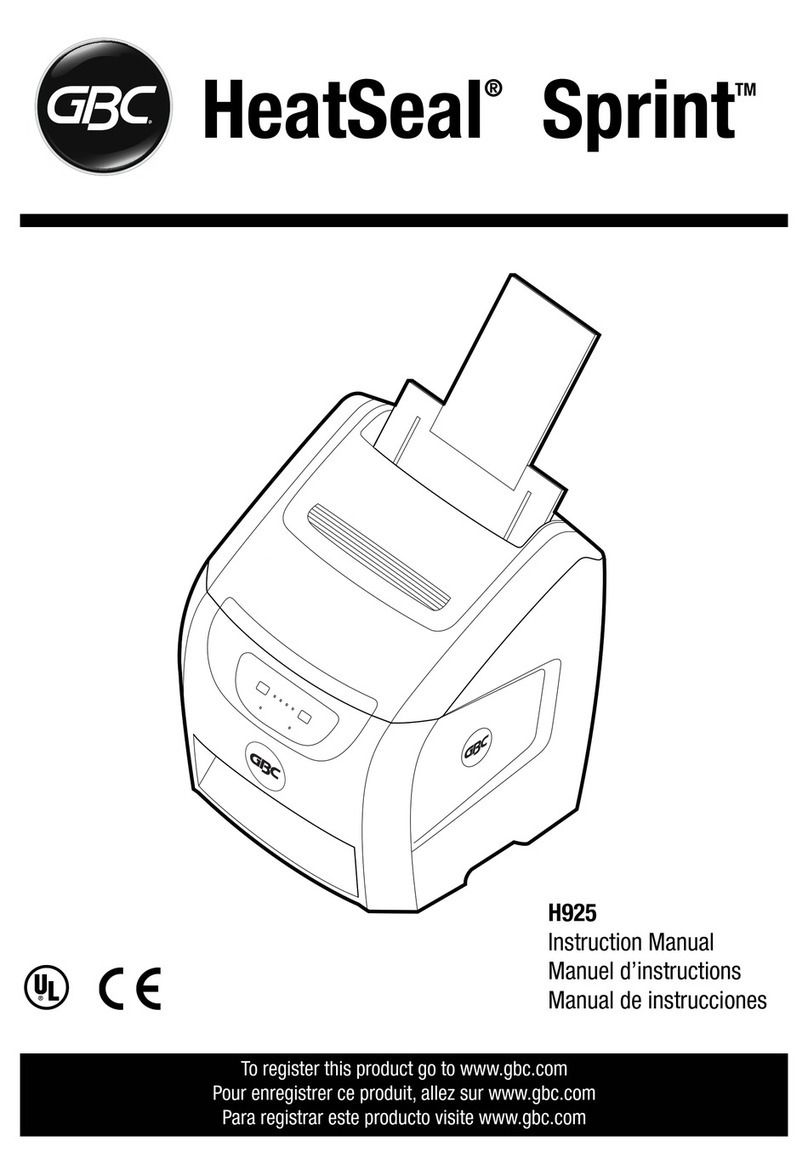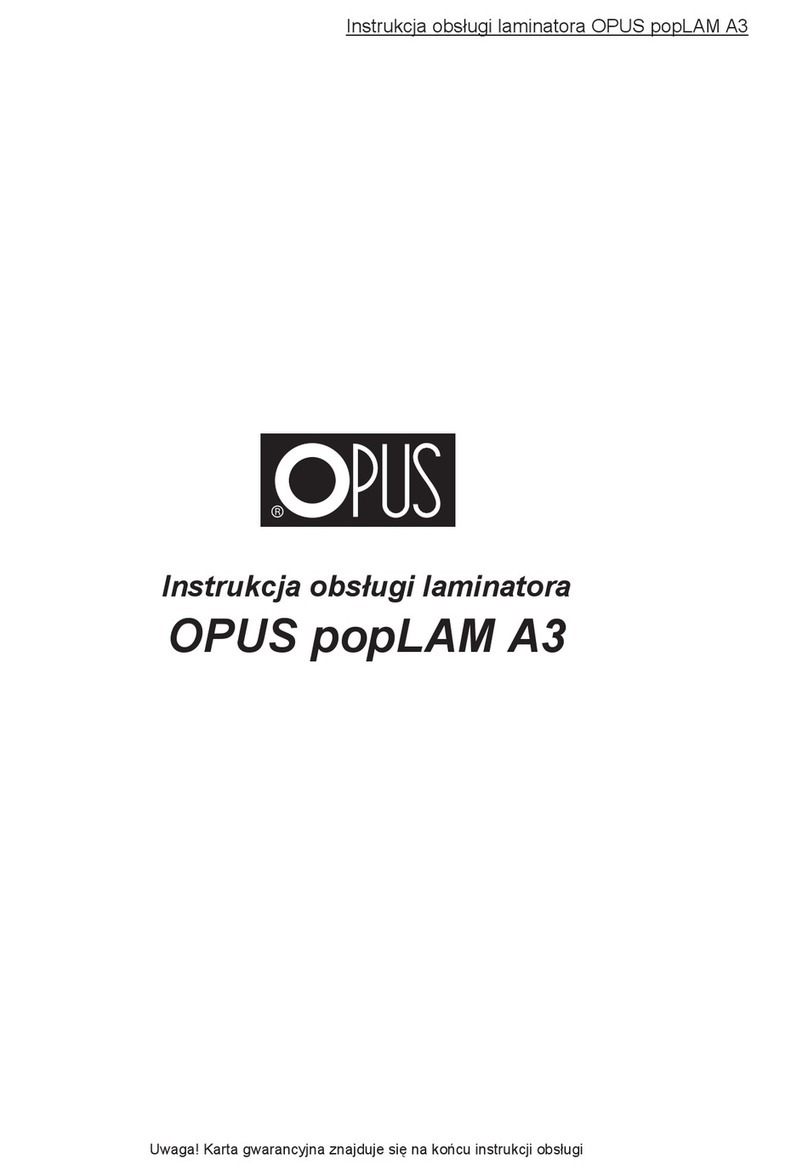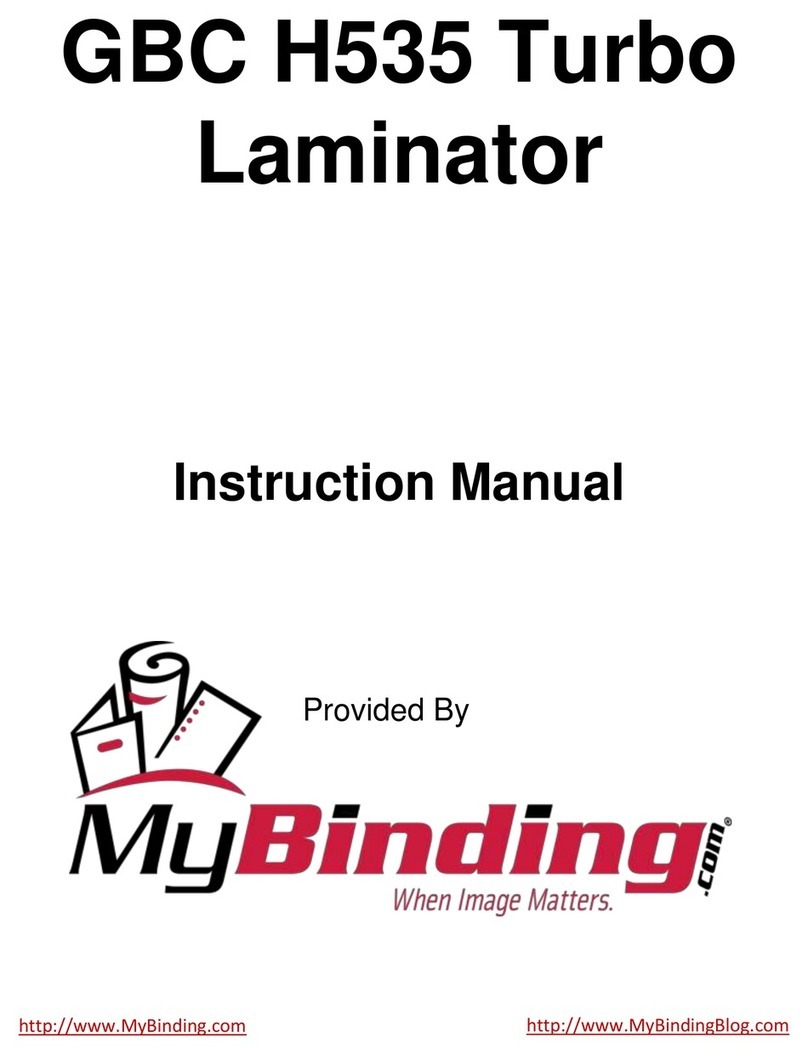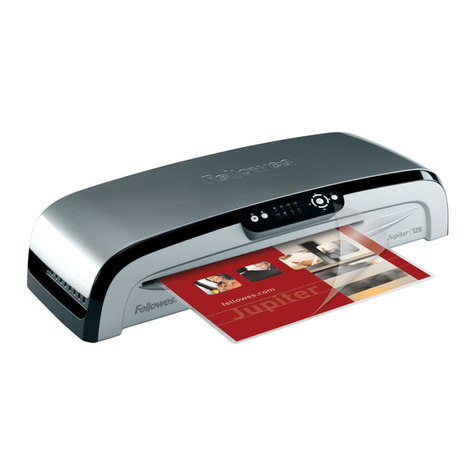Linea DH-1100 User manual

OPERATION MANUAL
on
ROLL LAMINATOR
Product instruction manual
Linea DH-1100
The Linea has been designed to be user friendly,
however we strongly recommend you take a few minutes
to read through this manual to ensure correct operation.
Keep this manual safe for future reference.

Warranty & Incorrect Use
IMPORTANT INFORMATION
Your Linea Roll Fed Laminator should reach you in perfect condition, however please retain all original packaging once you have
unpacked your Laminator as this system is covered by a return to manufacturers warranty. If your Laminator arrives damaged or
faulty in anyway this must be reported to your supplier immediately. If you send your Laminator back for repair at any time , then
the warranty may be void if the Laminator is not packaged correctly and as a result is damaged in transit. The laminator you have
misfeeds or Film wrapped around the rollers caused by operator error and you will be liable for the repair costs (including any
delivery charges).
The Laminator rollers are covered against manufacturing defects, they are not covered against any damages caused by misuse
ie. being cut with a knife or damage from non Laminating incidences.
E&O.E

1
WARNING
Please do not use broken, aging or self-made electrical wire and damaged supply cord.
Please do not immoderately draw, twist or enlace the electrical wire, to avoid the fire or
electric shock.
Please do not use the power supply that is not in accordance with the rated voltage, to
avoid the fire or electric shock.
NO DISJOINT
ENTANGLEMENT
CAUTION
ELECTRIC SHOCK
CAUTION
HIGH
TEMPERATURE
CAUTION
Don't disjoint, modify and repair the machine yourself.
If there are any problems on the machine, please do not
use it, send it to the dealer for repairing.
If the supply cord is damaged, it must be replaced by
the manufacturer, its service agent or similarly
qualified persons in order to avoid a hazard.
Keep hands, long hair, loose clothing and articles such
as ties or necklaces away from the front of the heating
roller and pull roller to avoid entanglement.
In case some articles entangled, press the FWD / REV
switch to REV right away; if not workable, cut off the
power supply at once, and contact your dealer for
settlement.
Do not put articles on the laminator while it is working,
so that to disperse the heat.
Do not insert the easy-burnt or easy-softened material
into the machine, in case they are melt and give rise to
smoke.
Do not touch the cover, heating roller and heating parts
while the machine is working, in case heat injury.
SAFETY PRECAUTIONS
Do not make the electrical wire or plug or the machine
bedewed by water or other liquids.
Do not operate the machine with wet hand.
Do not make the machine pressing on the electrical
wire.
Do cut off the power supply while moving the machine.
Do not operate the machine with the cover open.
The power socket must be properly grounded.

SAFETY PRECAUTIONS
2
CAUTION
WORKING
PLACE
This machine should be put at the dry and clean place, do not put it
at the damp place or near the exit of cooling appliances.
This machine should be put on the horizontal and firm place. In
front and rear of the machine, there should be sufficient place for
the document in and out.
Do not put any articles on the machine.
LAMINATING
FILM
Please use good quality laminating film, in order to show the
lamination effect, and avoid the entanglement.
OBJECT
The laminating machine use the hot press technology, do not use the
following objects in case laminating failure or laminating film
entangle.
1.Easy-burnt material, easy-softened material
2.The document printed by heat-sensitive paper, or any articles
that can be faded or transformed after heating.
3.Any articles that have drape, breakage, dampness or
deformation before laminating.
4.Coin or any other hard articles.
means exception while cold laminating operation.
Do not attempt to laminate articles that exceed total recommend
material thickness.
MACHINE
OPERATION
Do not turn to other usages except the usage range stated in this
operation manual.
Do not use the machine outside the room. Before leaving, please cut
off the power supply if the operation is over.
If there are any problems on the machine, please do not use it,send
it to the dealer for repairing.
While operating the machine, mind the children nearby, in case any suddenness.
Do not suspend the electrical wire on the table or cabinet or any other places
that the children can touch, or place easy stumble persons.
Using the accessory that not recommended or sold by the manufacturer, might
cause damage on the machine.
The photo or document once is laminated, it will become permanent and will
not be taken apart.
Please do not laminate the collected rare articles, or some articles might be
taken out in the future.
ADVICES

LCD
Speed control knob Temp. control knob
Load button
FWD / REV switch
RUN / STOP switch
STRUCTURE AND CONTROL PANEL
3
m m
HOT / COLD switch
Top roll shaft
Right side cover
Feed table
Roller pressure
knob
Top supply roll
tension knob
Safety shield
Control panel
Core adapter
Top stabilizer
bar
Feed guide
Bottom supply
roll tension knob
Bottom roll
shaft
Active bolt
Stand
Take-up bobbin
tension knob
Take-up bobbin
Heating roller
Emergency stop
Left side cover
Bottom stabilizer bar
Base plate (optional)

1. LCD display and Function
When the sensor is in open circuit,
OPN FAULT displays on the LCD.
When the sensor is in short circuit,
CLS FAULT displays on the LCD.
2. Function of control panel
1) Temperature control knob
Protecting function of temp sensor's open circuit and shot circuit
Note: No matter what problems happened, the machine will cut off the
heating power supply automatically, and the motor will stop running.
FUNCTIONS OF LCD DISPLAY
AND CONTROLPANEL
-
4. 2 155
FAULT
4. 2 1
-
INSTALLATION
1.Upon receipt of the laminator, inspect of box, the machine and all other
contents of the box for shipping damage. Shipping damage should be brought
to the immediate attention of the delivering carrier.
2.The laminator comes fully assembled on a stand .
3.Screw the wheel on the stand, put the stand upright. Place the tie bar
horizontally, connect the bar and stand with the bolt which has spring washer
on it, then fasten it.
4.Put the laminator on the assembled stand.
5.Start operation after turning the wheel stop switch to "OFF".
4

4) HOT / COLD switch
5) RUN / STOP switch
6) LOAD button
Press HOT / COLD switch can change the function of machine between
hot and cold lamination.
A)While set the HOT / COLD switch to HOT, the machine is on hot
laminating, the set temperature will display on the LCD.
B)While set the HOT / COLD switch to COLD, the machine is on cold
laminating, COLD will display on the LCD.
Press RUN / STOP switch can change the working condition of the
motor.
A)While set the RUN / STOP switch to RUN, the motor of the machine
works.
B)While set the RUN / STOP switch to STOP, the motor of the machine
stops, STOP will display on the LCD.
When the safety shield or feeding table are taken out, the machine will
not run. Set the speed at minimum speed, press the LOAD button
continuously, the machine can run at minimum speed, you can either
load the film or clean the roller.
FUNCTIONS OF LCD DISPLAY
AND CONTROL PANEL
5
A)Turn the temperature control knob can increase or decrease the set
temperature. The set temperature will display on the LCD.
B)The range of temperature that can be adjusted manually is 0 -140 .
C)The true temperature of the roller will display on the LCD.
D)When the true temperature reach 140 , the over-heat protecting
system will run automatically.
2) Speed control knob
A)Turn the speed control knob can increase or decrease the laminating
speed. The set laminating speed will display on the LCD.
B)The max. laminating speed is 1.4 m/min.
3) FWD / REV switch
Press FWD / REV switch can change the working direction of the motor.
A)While set the FWD / REV switch to FWD, the motor runs forward,
Will display on the LCD. The laminating film in, the machine works.
B)While set the FWD / REV switch to REV, the motor runs reverse,
REVERSE will display on the LCD. The laminating film out. This
function is used for remove the object inserted by mistake.

2) Insert the plug into the power socket that is grounding correct.
3) Turnon thepowerswitch, the LCD light, it indicates the power is connected.
2. Motor overload circuit breaker
This machine is equipped with motor overload circuit breaker (it is located next
to the power switch), in order to protect the motor working normally. When the
motor is overload, the circuit breaker will jump and cut off the motor power. One
minute later, when the overload is clear, press the circuit breaker button, the
motor will start again.
3.Film threading
HOT FILM
Step 1: Raising the safety shield.
Remove the active bolt on the shield, raise the safety shield.
Step 2: Taking out the feed table.
Remove the active bolt under the feed table, take out the feed table.
Remark: the machine will power off when the safety shield and the feed
table are not in their proper positions.
OPERATION INSTRUCTIONS
OPERATION INSTRUCTIONS
PREPARATION
1. Connecting the power source
1) Checking the rated voltage on the machine, to insure it conform to the power
source. Also, checking the plug to insure it conform to the socket.
3. Emergency Stop
There is a emergency stop button on the front of
the laminator. In emergency situation pressing the
button will stop the rollers and stop heating. Rotate
the button to the direction of arrow to turn on the
power supply.
POWER
SWITCH
WIRE CIRCUIT
BREAKER
FAN
SWITCH
FAN
ON
OFF
POWER
ON
OFF
6

CAUTION: For hot laminating, the top and bottom roll film must have same
width, besides, the top film and bottom film must be aligned. (If the film is not
in alignment, loose the bolt on core adapter and align it.)
Step 4: With both roll films threaded and installed in their respective brackets,
unwind the top and bottom supply rolls about half-turn each. This will provide
enough slack in the web to allow the feed table to slide on easily.
Step 5: Slide the feed table into position and lock the active bolt.
OPERATION INSTRUCTIONS
7
Step 3: Follow the diagram to thread the film
Remark: Usually the shiny side is the polyester side, it contact the roller.
The dull side is coated with adhesive. For the matte film, the two sides have
minor difference, please especially be careful. Heat the film with lighter can
easily tell the polyester side and adhesive side. The adhesive side must face
away against to the roller.
Slide the roll film onto the roll shaft (follow the above instruction, do not load
the film in wrong side). Hold the roll film on the core adapter, the core adapter
can hold the core of the roll film, to prevent it rotating. Screwing the bolt on the
core adapter. Put the rolls on the brackets. Make sure it is fully seated.
Top roll film
Bottom roll film
Top stabilizer bar
Bottom stabilizer bar
Top heating roller
Bottom heating roller
Top pull roller
Bottom pull roller
Film ou tsid e top
stabilizer bar
Top roll film
Top stabilizer bar
Top heating roller
Film inside top
sta bilizer bar
Bottom roll film
Bottom stabilizer bar
Bottom heating roller
Top pull roller
Bottom pull roller
Film Threading Diagram
Tension knob
Spring
Bracket
Friction plate
Bushing
Core adapter
Roll film Bolt Bracket
Bushing
Core adapter
Bolt
Tension knob
Friction plate

Step 6: Position the safety shield forward toward the roller and lock the active
bolt.
Remark: The machine will not power on without the feed table and the safety
shield in the proper positions.
Step 7: Make sure there is still enough slack in the web. Close the rollers with
the knob on the right side of the laminator. With the film draped over the two
heating rollers, and melted or taped together, push one edge of the threading card
between the heating rollers so that the film is firmly positioned. Make sure the
rollers are in closed position. If a threading card is not available, any piece of
card stock or poster board will work.
Step 8: Set the FWD / REV switch to FWD and set the RUN / STOP switch to
RUN. If the film and the card are in the nip (the point where the top and bottom
roller meet), the film and the threading card will start into the laminator and will
pass through both sets of rubber rollers. When the threading card has cleared the
back of the machine, set the RUN / STOP switch to STOP.
CAUTION:For operator safety, the safety shield must be in position over the
upper heating roller when the machine is ON.
COLD FILM
Step 1: Raising the safety shield.
Remove the active bolt on the shield, raise the safety shield.
Step 2: Follow the diagram to thread the film
Slide the roll film onto the roll shaft (follow the above instruction, do not load
the film in wrong side). Hold the roll film on the core adapter, the core adapter
can hold the core of the roll film, to prevent it rotating. Screwing the bolt on the
core adapter. Put the rolls on the brackets. Make sure it is fully seated.
OPERATION INSTRUCTIONS
8
Top heating roller
Bottom heating roller
Cold film
Top stabilizer bar
Top pull roller
Bottom pull roller
Take-up bobbin
Back paper

Step 3: Insert a piece of wide cardboard (guiding paper) between the rollers. the
width of cardboard should be larger than the width of cold film. Pull the film
from the top roller passing over the top stabilizer bar to the top roller.
Step 4: Put the paper back of the cold film to the bobbin at take-up bar to rewind
the paper back. Allow some of the cold film with melted resin to stick the wide
cardboard (guiding paper).
Step 5: Position the safety shield forward toward the roller and lock the active
bolt.
Step 6: Close the rollers with the knob on the right side of the laminator. Set the
FWD / REV switch to FWD and set the RUN / STOP switch to RUN. The films
will be fed into the machine. Check the status of lamination.
Remark: The machine will not power on without the safety shield in the
proper positions.
HOT LAMINATING
1.Turn on the machine, set the RUN / STOP switch to STOP, set the HOT /
COLD switch to HOT. The machine begin heating. Turn the temperature knob to
the temperature for whatever film is being used.
2.The laminator will be ready to operation in about 10 minutes.
1) Trial lamination
If the roll film is the first time to be used, the trial lamination is required for
perfect result. After the true temperature of the roller reach to the set temperature,
close the rollers with the knob on the right side of the laminator, set the FWD /
REV switch to FWD and set the RUN / STOP switch to RUN, let at least 250mm
of film go through the rollers before inserting the items to be laminated.
Examine the film coming out the back of machine.
Adjust the machine according to the above instructions until you have the
perfect lamination result.
2) After the trial lamination has a satisfied result, position the feed guides
according to the width of the item to be laminated, entering the item in the web
of film.
Remind: keep clear and enough space behind the machine, so that the
laminated item can come out easily, it will not wind onto the rubber roller. If
the machine is stopped for a long period, set the temperature decreased by
5-10this will prolong the work-life of the machine.
Stop the machine after the item to be laminated pass through the roller
completely, otherwise there will be an imprint on the item.
OPERATION INSTRUCTIONS
9

Temperature setting
Normally, your film supplier should provide the information about the film
application temperatures and operating characteristics. If you do not know the
source of your film, or if the supplier cannot provide the information, please try
the temperature and speed until you have the best result.
COLD LAMINATING
1.Set the HOT / COLD switch to COLD.
2.Set the speed to the required speed.
3.Put the document on the feed table.
4.Set the FWD / REV switch to FWD and set the RUN / STOP switch to RUN.
5.Stop the machine after the document to be laminated pass through the roller
completely, otherwise there will be an imprint on the document.
CAUTION:The adhesive side must face away from the roller.
GENERAL MAINTENANCE
Do not laminate the metal or other hard items in case the damage of the rubber
rollers.
While stop the laminating, lift the top rubber roller with the knob on the right
side of the machine. Do not press the rubber roller in case the rubber become
stiff and thus shorten its work-life.
Cleaning the machine timely will help prevent dirt or adhesive build-up on the
rubber rollers and will improve the performance of the unit.
CLEANING THE RUBBER ROLLERS
During the normal lamination, excess adhesives from the film will often cling to
the rubber rollers.
To clean the rubber rollers, lift the rubber roller, remove the film from the
machine first, heat up the machine to 30-40 . The warm roller enable it
easier to remove the adhesive built-up on the rollers. Raise the safety shield
and take out the feed table. Using a clean, soft, ethanol dampened cloth,
gently rub the adhesive off the rollers.
CAUTION:Never use any abrasive or sharp metal material or rub too hard
on the roller, because you may damage the rubber surface.
MAINTENANCE AND SERVICE
10

Set the speed at minimum speed, press the LOAD button, the roller will run,
cleans the roller. After cleaning, position the feed table and slide on the
safety shield.
CAUTION:If the film gets wrapped around the roller, set the RUN/STOP
switch to STOP immediately, set the HOT / COLD switch to COLD.
WARNING:Do not use any cleaning solution to clean the roller, because
some solutions may burn on the hot roller. After the roller cool down, cut
the film on the top and bottom, just in front of the stabilizer bars. Reverse
the roller at a very low speed and allow the machine to back out the film that
is wrapped around the rolls, pull the film off the roller. Clean the adhesive
on the roller.
PROBLEM SOLUTION
Please read this section before you have a problem
PROBLEM:No power is getting to the machine.
SOLUTION:Make sure there is power at the electrical outlet being used, and
make sure both ends of the power cord are firmly engaged.
The laminator equipped with three fuses (one is located next to the power switch,
the other two are located under the bottom of laminator). Please check these
fuses.
PROBLEM:Wrinkling of the film around the material being laminated.
SOLUTION:This is normal and inevitable on any laminator, especially with
thicker material. These wrinkles will be trimmed away with the scrap, so they do
not affect appearance. Because the rollers are being held apart by the paper, they
cannot pull equally on the plastic around the paper. This creates wrinkles that
tend to look like the bow waves of a boat, radiating out through the clear part of
the web from the sheet of material.
PROBLEM:When two pieces of material are laminated side by side, the plastic
adhesive to one piece but not the other.
SOLUTION:To get maximum efficiency from the film rolls, you can feed
several items into the laminator side by side. However, wrinkling can occur if
these items are of unequal thickness, because the laminating rollers are lifted off
the thinner items by the thicker items. When laminating items side by side, it is
important to arrange them so that the thickness is the same.
MAINTENANCE AND SERVICE
11

12
MAINTENANCE AND SERVICE
PROBLEM: Film gets wrapped around the laminating rollers while hot
laminating.
SOLUTION:The film is threaded improperly. If the adhesive side face to the
roller, the film will be wrapped around the rollers. Thread the film in proper
position.
The laminating temperature is too high, the film will be melted and wrapped
around the roller. Decrease the laminating temperature.
Set the RUN / STOP switch to STOP immediately, set the HOT / COLD switch
to COLD. After the roller cool down, cut the film on the top and bottom, just in
front of the stabilizer bars Reverse the roller at a very low speed and allow the
machine to back out the film that is wrapped around the rolls, pull the film off
the roller.PROBLEM: Wrinkling of the plastic on a laminated material.
SOLUTION:Check the tension of the film, make sure the film is threaded
properly (see film threading).
PROBLEM:Film is not properly adhered.
SOLUTION: The laminating temperature is too low, there is not enough
heat for melting the adhesive. Increase the laminating temperature.
PROBLEM: The laminated material seems to have a irregular surface that
does not match the texture of the paper being coated.
SOLUTION:This is usually caused by adhesive build-up or dirt on the
rubber rollers. Inspect the rubber rollers and clean it.
Damages to the rubbers can also cause irregularities in the surface of the
film.
PROBLEM:General haziness or cloudiness in the film after lamination.
SOLUTION:Increase the temperature or decrease the speed. That
cloudiness is a function of incomplete adhesion. On a variable speed
machine loaded with thicker film, it may be that the film is being run too
fast.
.

SERVICE
If the service is required, please provide the following information:
The detail of the problem
Installation Date
Serial number
Model 1100
Operate modeElectric
Max. laminating width 1050 mm
Max. laminating thickness 5 mm
Max. laminating temperature140
Max. Laminating speed 1.8M/min
Recommended film Up to 250 mic
Temperature control 8-bit microprocessor
Heating method Heating roll
Power supply AC100,110,220-240V/50,60Hz
Power consumption 2700W
Dimensions (L x W x H) 1350 600 1170 mm
Weight 155 kg
SPECIFICATION
13
Other manuals for DH-1100
1
Table of contents
Other Linea Laminator manuals


